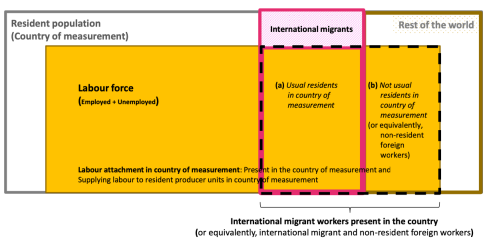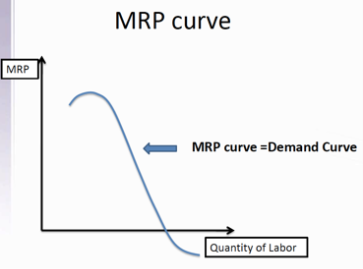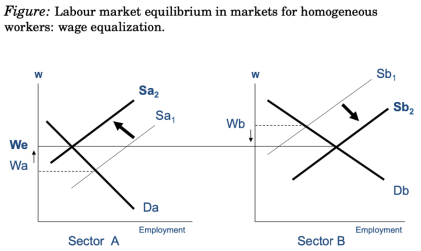UNIT -2
Labour Market
The labour market, also known as the job market, refers to the supply of and demand for labour, in which employees provide the supply and employers provide the demand. It is a major component of any economy and is intricately linked to markets for capital, goods, and services.
Labour supply( LS)

 The supply curve for labour is defined as the average factor cost curve.
The supply curve for labour is defined as the average factor cost curve.
 It is better to increase a worker’s wage as you can see through a percentage then lumpsum as this translates into a shift of the budget constraint.
It is better to increase a worker’s wage as you can see through a percentage then lumpsum as this translates into a shift of the budget constraint.
Dimensions of LS:
1 quantity dimensions: extensive margin (work or not),
2 intensive margin (how much to work)
3 quality dimensions (effort, education)
Labour demand (LD)
Labour demand is derived as it is the result of the demand for a good or
Service that is created by labour inputs.
Factors affect for labour demand
- Wage rate
- Unit cost of capital
- Selling price of output

What decisions do individuals make?
1 Whether or not to join the labour force.
2 Which occupation/industry to join.
3 How many hours to work.
4 Whether or not to join a union.
5 How much education to obtain.
6 When to retire.
7 Where to live.
What decisions do firms make?
1 How much labour to hire.
2 What wages to pay.
3 What hours of work to require.
4 When to lay-off workers.
5. Plant closings, outsourcing, etc.
What decisions does government make?
- Set rule in the labour market (minimum wage, etc.)
- Rules governing maternity leave, pensions, etc.
- Workers compensation, unemployment benefits.
→ Governments as legislators and policymakers establish the environment in which individuals and firms interact.
Characteristics of labour market
- Institutional constraints (unions): important in countries where large work force is unionized
- Legislative constraints: employment standards laws; human rights and antidiscrimination legislation; laws on health and safety and workers’ compensation, etc.
- Market imperfections: imperfect information, asymmetric information, transactions costs, uncertainty and risk.
- Complex price
- Reflects a variety of factors: returns to investments in education, training, mobility; compensation for risk or undesirable working conditions; a rent from a union or an industrial wage premium; discrimination.
- Perform a variety of functions: allocates labour efficiently across industries, occupations, regions; encourages optimal investments in human capital; provides incentives for performance, work effort, productivity; should provide an adequate standard of living and alleviate poverty and discrimination.
- Strong moral overtone: labour services and the labourer are not separable - dignity, perceptions of self-worth, prestige, and well-being are tied to wage. A job is an important aspect of “who you are”.
Alternative Perspectives of the Labour Market
The labour market has a number of features that distinguish it from other markets.
The traditional neoclassical model: oversimplification unable to account for many labour market phenomena. Alternative perspectives:
- Institutionalism: emphasis on the descriptive realism and the roles of institutions, customs, and socio-political factors.
- Dualism: based on segmented labour market tradition – primary and secondary.
- Radicalism: emphasis on the class conflicts as the main determinant of the labour market outcomes.
International labour migration is used as a generic term to refer, in general, to concepts related to the process and outcome of international labour migration, especially to:
- International migrant workers
- For-work international migrants
- Return international migrant workers
The world is being transformed by the globalization process. States, societies, economies and cultures in different regions of the world are becoming increasingly integrated and interdependent. New technologies make it possible for capital, goods, services, information and ideas to move quickly from one country and continent to another.
The International Labour Organization is a United Nations agency whose mandate is to advance social and economic justice through setting international labour standards. Founded in 1919 under the League of Nations, it is the first and oldest specialised agency of the UN.
Diversity of migration
There are many ways of distinguishing different groups of migrant workers, based on motivation for migrating, skills, age, sector, occupation and distance from origin. The distinctions most commonly used are based on anticipated duration of stay, reflecting the fact that control over who enters a country and how long they stay is a core aspect of national sovereignty. On this basis, the admission of migrant workers falls into two broad categories:
- Permanent migration: referring to admission of workers falling under different immigration categories (i.e. family reunification, highly skilled) for an indefinite period of stay, that is, a stay without a time limit imposed by the destination country.
- Temporary migration: referring to admission of workers (sometimes referred to as “guest workers”) for a specified time period, either to fill year-round, seasonal or project-tied jobs, or as trainees and service.
Migration: Growth and development impacts in countries of origin and destination
Labour migration has the potential to serve as an engine of growth and development for all parties involved – destination countries, origin countries and migrant workers themselves. In destination countries, migration has rejuvenated workforces, rendered many traditional sectors like agriculture and services eco- nomically viable, promoted entrepreneurship, supported social security and welfare schemes, and satisfied the demand for skills in emerging high-tech industries. In the developing regions from which most migrants come, the positive contributions of migration are reflected in high remittance flows and the transfer of investment, technology and critical skills through return migration and connections with trans- national communities
Return migration and circular migration
Return migration has traditionally been viewed as a good strategy to reverse brain drain, and considerable interest has been expressed in the return migration of skilled workers as a major positive factor for the development of origin countries.
The actual impact of return migration depends on a number of factors, including reasons or motives for return, time pattern of return, and timing of return
Schematic representation of the measurement framework of international migrant workers

International labour migration is characterized by:
- Directionality – distinguishes between entry and exit on international migrant workers in the country of measurement.
- Duration – refers to the duration of stay in country of labour attachment.
- Nature – refers to permanent or temporary stay in the country of labour attachment.
India possesses a large labour pool as almost half its population of 1.2 billion is of working age. Naturally, the structure of India’s labour market is diverse; foreign companies need to understand this structure to benefit from India’s demographic dividend.
A majority of the working population is engaged in the unorganized, or informal sector, working for small businesses or manufacturing units that employ less than ten individuals. Businesses that don’t need skilled labour can source employees with some ease.
The expansion of higher education has created a larger skilled talent pool, but it still only amounts to about ten percent of the country’s overall labour market. Companies seeking skilled labour need to be prepared to compete to recruit from this comparatively small pool.
Structure of labour in India
The government’s labour laws usually classify employees on the basis of skill and area of operation. In terms of skill, employees are categorized as unskilled, semi-skilled, skilled, and highly skilled. In terms of area of operation, employees are categorized as managerial personnel and workmen. This defines their job roles, wages, disbursal of benefits, and their rights and obligations.
Labour costs in India
Firms entering the Indian market often choose to make the decision after assessing the comparative costs of labour. India offers competitive advantages with its lower wage structure and access to a vast labour market. For instance, the average minimum wage for contract workers in India is US$148 per month (Rs10,000) and US$234 in China.
Individuals, Firms, and Government interact to determine labour market outcomes:
1 Prices (wages, wage differentials).
2 Quantities (employment and unemployment)
Factors influencing labour market outcomes:
1 legislative interventions
2 unions and collective bargaining
3 markets structures (in both the product and the labour markets)
→ Labour economics involves analysing the determinants of the various dimensions of labour supply and demand.
Labour Demand Curve in perfectly Competitive Market


Profit maximization
• Economic profit = TR - TC
• By adding a worker; TR TC
TC
• A firm will add more labour if; TR  > TC
> TC
Marginal Revenue Production
MPR is the additional revenue that results from the use of an additional unit of labour
 MRP = TR
MRP = TR
 L
L

MRP, MFC & Profit Maximization
• A firm will use more labour if MRP > MFC
• A firm will use less labour if MRP < MFC
• A firm maximizes its profit at the level of labour use at which MRP = MFC

The Neoclassical Model of Supply and Demand
Workforce of labour economics/Foundation to explain the level of employment and wages.
Key assumptions:
1 Individuals and firms simultaneously act in their own best interests
2 Perfect competition of the labour market
3 Perfect information
4 No transaction costs

Competitive behaviour:
- Market wage taken as given (a single agent can’t affect the market wage by its action)
- Quantity of labour determined by agents’ supply or demand curves
How is the equilibrium market wage determined?
- Assume exchange is voluntary and consider W’
- Excess supply: some workers willing to work for slightly less and some firms to hire for a slightly lower wage.
- In the absence of rigidities, competitive pressures lead the wage to fall toward W*

- Consider homogeneous workers in two separate markets (e.g. Regions or occupations)
- At the outset, Wa < Wb.
- Can’t be an equilibrium, unless barriers (e.g. Imperfect information about wages, switching costs) prevent workers in A from moving to B.
- Individuals in A move to B, producing a contraction of labour supply in A and an expansion of it in B.
- Workers switch to B until wages are equalized across markets.
The neoclassical model of supply and demand suggests we can study labour markets just like we study the market for other commodities.
If so, why have a separate field for labour economics?
Because the labour market has a number of characteristics that differentiate it from many other markets and cause it to function differently from a spot market:
- Stakeholders with a variety of goals
- Labour: non-union and union labour; different types of unions (i.e. industrial or professional).
- Management: stockholders, chief executive officers, middle management.
- Government: federal, provincial and local levels; differences in the units that make and enforce the law and operate government programs.
2. Sociological constraints
- The role of women in the labour market
- Family and community ties affecting labour mobility
- Social norms influencing what is considered an appropriate wage and who should do certain jobs
Does this mean we cannot use the basic tools of the neoclassical model to study the labour market?
Not necessarily.
- It often proves to be a good benchmark or useful approximation.
- It provides a good theoretical foundation of the labour market and of market clearing forces.
- It has evolved to incorporate imperfect competition, imperfect information, incentives, transaction costs.
- Adaptable enough to remain the dominant paradigm for analysing labour market phenomena.
Collective bargaining is a process of negotiation between employers and a group of workers aimed at agreements to regulate working salaries, working conditions, benefits, and other aspects of workers ‘compensation and rights
- The interests of the workers are commonly presented by representatives of a trade union to which the workers belong.
- The collective agreements reached by these negotiations usually set out wage scales, working hours, training, health and safety, overtime, grievance mechanisms, and rights to participate in workplace or company affairs.
- A collective agreement functions as a labour contract between an employer and one or more unions.
Role of Government in collective bargaining
It can decide certain working conditions bylaw. For example, setting minimum wages, preventing ethnic discrimination and other such acts can be enforceable by law.
• It may settle disputes which the employer and the labours are unable to settle by themselves.
• It may provide certain benefits directly, like pensions.
• It may set ground rules which govern the parties conduct. For example restricting and regulating the conditions under which labour can do strikes
Collective Bargaining in India
• The commencement of collective bargaining in India can be traced in the year 1918 in Ahmedabad
• National Commission on Labour and Collective Bargaining- This commission was set in 1966 in India which aimed at making comprehensive investigations into almost all the problems relating to labour.
• The First Five-Year Plan duly recognized the need for collective bargaining to resolve labour disputes and maintain peaceful industrial relations in the country.
Obstacles to Collective Bargaining in India
Process of collective bargaining is not very encouraging in India, following can be the reasons-
• Multiple unions
• Defective laws
• Mediation by political leader(s)
Key takeaway
Demand and supply of labour
Individuals, Firms, and Government interact to determine labour market outcomes:
1 Prices (wages, wage differentials).
2 Quantities (employment and unemployment)
Factors influencing labour market outcomes:
1 legislative intervention
2 unions and collective bargaining
3 markets structures (in both the product and the labour markets)
Equilibrium market wage determination

Collective bargaining is a process of negotiation between employers and a group of workers aimed at agreements to regulate working salaries, working conditions, benefits, and other aspects of workers' compensation and rights.
Role of Government in collective bargaining
It can decide certain working conditions by law. For example, setting minimum wages, preventing ethnic discrimination and other such acts can be enforceable by law.
• It may settle disputes which the employer and the labours are unable to settle by themselves.
• It may provide certain benefits directly, like pensions.
• It may set ground rules which govern the parties conduct. For example restricting and regulating the conditions under which labour can do strikes
International labour migration is used as a generic term to refer, in general, to concepts related to the process and outcome of international labour migration, especially to:
- International migrant workers
- For-work international migrants
- Return international migrant workers
Reference:
1. Labour Economics by G.P. Sinha
2. Labour Economics by T.N.B Bragoliwal